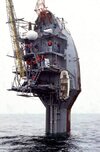Floating Instrument Platform (FLIP) is a unique oceanographic research vessel owned by the Office of Naval Research (ONR) and operated by the Marine Physical Laboratory at Scripps Institution of Oceanography.
The vessel is a 355ft long, spoon-shaped buoy, which can be flipped from horizontal to a 90° vertical position in the ocean by pumping 700t of seawater into the ‘handle’ end while flooding air into the ‘cradle’, causing it to rise out of the sea.

The transition from horizontal to vertical positioning takes nearly 30 minutes, after which 300m of the buoy is submerged underwater, keeping the 700 long-ton mass steady, providing a stable research platform for underwater acoustics research.
The vessel is imperviable to wave motion, thus allowing researchers to conduct a range of research activities including meteorology, geophysics, physical oceanography, marine mammal research, non-acoustic ASW and laser propagation experiments in a stable environment.
Construction and maintenance of the research vessel
Launched in June 1962 by The Gunderson Brothers Engineering Company of Portland, the FLIP was designed by two MPL scientists, Dr Fred Fisher and Dr Fred Spiess, to create a more stable space than a conventional research ship to study wave forms.
The FLIP Maintenance Availability began at the Campbell Shipyard in December 1994 and was completed in January 1996. FLIP underwent constant dry dockings in 2001, 2003, 2006 and 2010, and completed 50 years of successful operations in 2012.
The FLIP transformation
The transformation from horizontal to vertical is one of the most impressive sights on the ocean. Because of the potential interference with the acoustic instruments, FLIP has no propulsion power, so has to be towed out to its operating area in the horizontal position at a speed of 7kt to 10kt.
“FLIP’s unique design makes it the only vessel in the world capable of operating both horizontally and vertically.”
When positioned at the desired location at sea, the research vessel either drifts freely or is held in place using one or all of its three anchors, as required by the research project. The long, thin end of the buoy has special ballast tanks, which are then flooded with seawater, causing it to sink, while air tanks cause the other end of the buoy to rise. The protruding end is equivalent in height to a five-storey building





